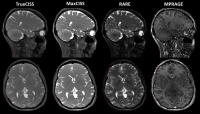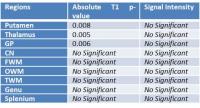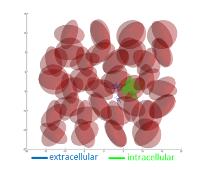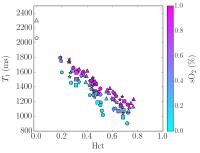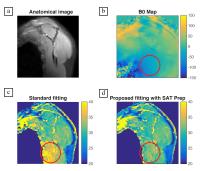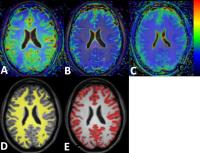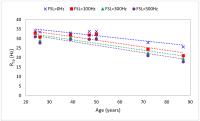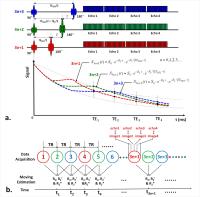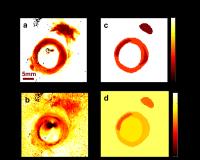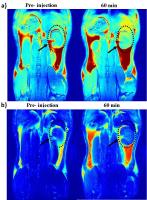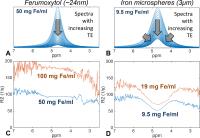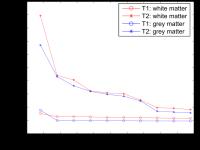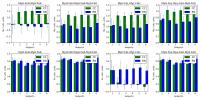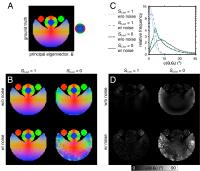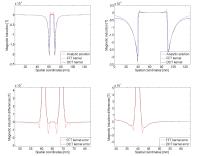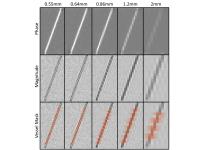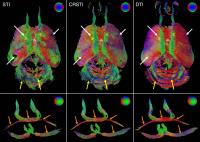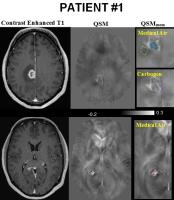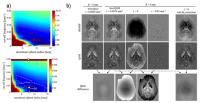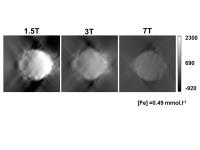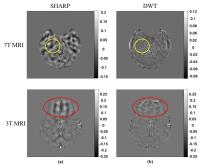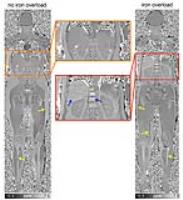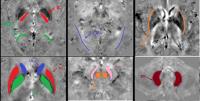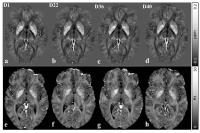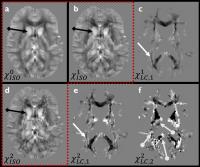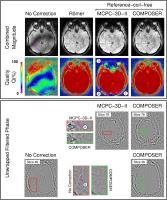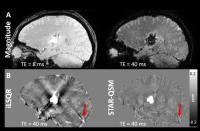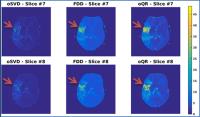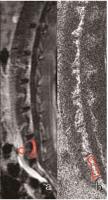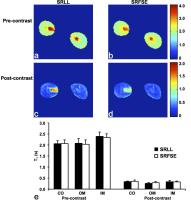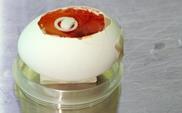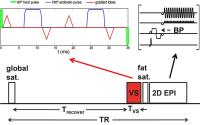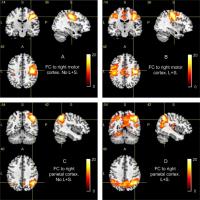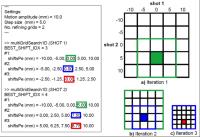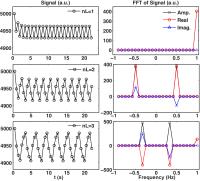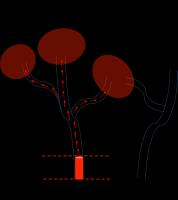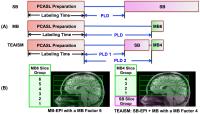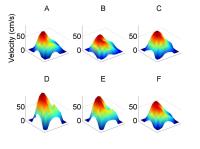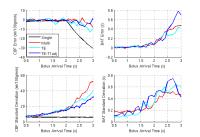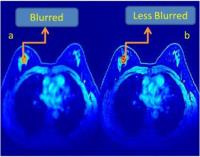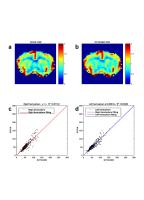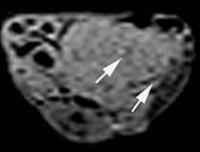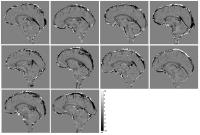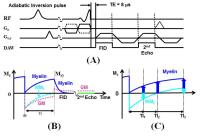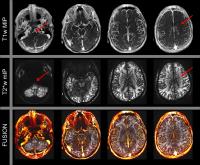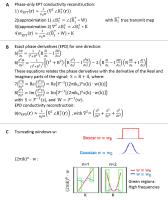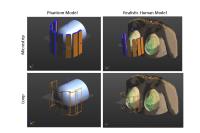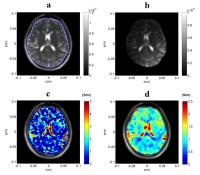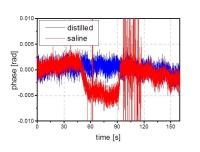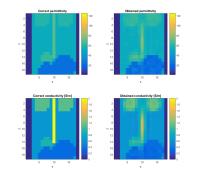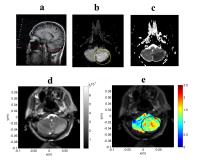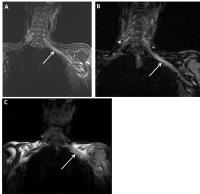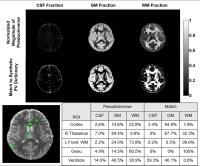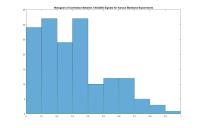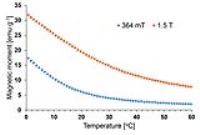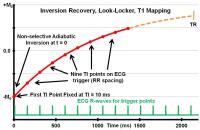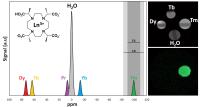|
Exhibition Hall 14:15 - 15:15 |
|
|
|
Computer # |
|
2888.
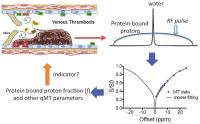 |
73 |
Staging deep vein thrombosis using quantitative Magnetization
Transfer 
Huanling Liu1,2, Wenbo Li1,3, Yuguo Li1,3,
Dexiang Liu1,2, Hanwei Chen2,3, Peter
C.M Van Zijl1,3, and Guanshu Liu1,3
1F.M. Kirby Research Center for Functional Brain
Imaging, Kennedy Krieger Institute, Baltimore, MD, United
States, 2Department
of Radiology, Guangzhou Panyu Central Hospital, Guangzhou,
China, People's Republic of, 3The
Russell H. Morgan Department of Radiology and Radiological
Science, Division of MR Research, Johns Hopkins University
School of Medicine, Baltimore, MD, United States
There is an urgent need for a quantitative imaging technique
that can stage deep vein thrombosis (DVT) and guide
thrombolysis treatment. In the present study, we explored
the ability of quantitative Magnetization transfer (qMT)
technique as a non-invasive means to stage thrombi based on
their macromolecular content. Thrombi in the inferior vena
cava were formed using a Mouse Complete Stasis Model. A
two-pool MT mathematical model was adapted to fit
high-resolution MT data of excised thrombi samples. The
results clearly showed that bound proton fraction (BPF) is a
useful parameter for distinguishing aged blood clots from
freshly formed ones.
|
|
2889.
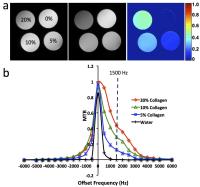 |
74 |
Noninvasive Assessment of Renal Fibrosis Using Magnetization
Transfer MRI in Murine Renal Artery Stenosis 
Kai Jiang1, Christopher M. Ferguson1,
Behzad Ebrahimi1, Hui Tang1, Timothy
L. Kline2, Prassana K. Mishra3, Joseph
P. Grande4, Slobodan I. Macura3, and
Lilach O. Lerman1
1Division of Nephrology and Hypertension, Mayo
Clinic, Rochester, MN, United States, 2Department
of Radiology, Mayo Clinic, Rochester, MN, United States, 3Department
of Biochemistry and Molecular Biology, Mayo Clinic,
Rochester, MN, United States, 4Department
of Laboratory Medicine and Pathology, Mayo Clinic,
Rochester, MN, United States
In this study, magnetization transfer was used to measure
renal fibrosis in a murine model of renal artery stenosis. A
collagen phantom study was performed to optimize the
irradiation-offset frequency of MT pulses. Renal fibrosis by in
vivo MT and ex
vivo histology
or hydroxproline assay showed a good correlation, suggesting
that MT could be used to assess renal fibrosis. In addition,
MT successfully captured the physiological changes at
different stages of renal fibrosis, indicating that MT was
capable of monitoring the longitudinal development of
functionally significant renal fibrosis.
|
|
2890.
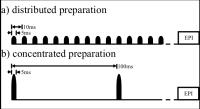 |
75 |
Increasing the inhomogeneous magnetization transfer (ihMT)
signal in vivo with high amplitude, low duty cycle irradiation 
Gopal Varma1, Olivier M Girard2,
Valentin H Prevost2, Guillaume Duhamel2,
and David C Alsop1
1Radiology, Division of MR Research, Beth Israel
Deaconess Medical Center, Harvard Medical School, Boston,
MA, United States, 2CRMBM-CEMEREM
UMR 7339, CNRS-AMU, Aix Marseille Université, Marseille,
France
High power, off-resonance irradiation as utilized in ihMT/MT
can saturate pools of bound magnetization before they
exchange in tissues. Observation of such saturation
phenomena is limited by power constraints in-vivo and by
attenuation of the free pool magnetization. A technique for
studying and enhancing saturation effects using relatively
short bursts of higher power irradiation is evaluated. The
results provided 2-5 fold increases in ihMTR (depending on
average power and offset frequency). Such short duration,
high power pulses offer a new window to probe exchange
kinetics and dipolar order effects, as well as enhancing the
quality and feasibility of ihMT imaging.
|
|
2891.
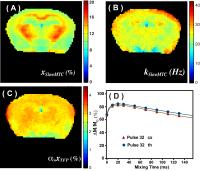 |
76 |
On-resonance Variable Delay Multi Pulse Scheme for Imaging of
Fast-exchanging Protons and semi-solid Macromolecules 
Jiadi Xu1,2, kannie W. Y. Chan1,2,
Xiang Xu2, Nibhay Yadav1,2, Guanshu
Liu1,2, and Peter C. M. van Zijl1,2
1F. M. Kirby Center, Kennedy Kriger Institute,
Baltimore, MD, United States, 2Russell
H. Morgan Department of Radiology and Radiological Science,
Johns Hopkins University School of Medicine, Baltimore, MD,
United States
An on-resonance variable delay multi-pulse (onVDMP) scheme
was developed for separation and quantification of
magnetization transfer contrast (MTC) and total
fast-exchanging protons (TFP) contributions. Phantom studies
of glucose, bovine serum albumin (BSA) and hair conditioner
show the capability of onVDMP to separate out exchangeable
protons with different exchange rates by their unique signal
buildup curves. Quantitative MTC and TFP maps acquired on
healthy mouse brains showed strong gray/white matter
contrast for the slowly transferring MTC protons while the
TFP map was more uniform across the brain.
|
|
2892.
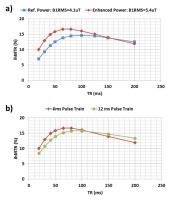 |
77 |
Theoretical and Experimental Optimization of a 3D Steady-State
Inhomogeneous Magnetization Transfer (ihMT) Gradient Echo
Sequence: Boosting the ihMT Sensitivity with Sparse Energy
Deposition 
Olivier M. Girard1,2, Gopal Varma3,
Samira Mchinda1,2, Valentin Prevost1,2,
Arnaud Le Troter1,2, Stanislas Rapacchi1,2,
Maxime Guye1,2, Jean-Philippe Ranjeva1,2,
David C. Alsop3, and Guillaume Duhamel1,2
1CRMBM, UMR 7339 CNRS, Aix-Marseille University,
Marseille, France, 2Pôle
d'Imagerie Médicale, CEMEREM, APHM, Marseille, France, 3Radiology,
Division of MR Research, Beth Israel Deaconess Medical
Center, Harvard Medical School, Boston, MA, United States
Inhomogeneous Magnetization Transfer (ihMT) has shown
improved specificity for myelinated tissue as compared to
conventional MT. Recently, fundamental developments have led
to theoretical modeling of the ihMT effect. In this study
forward modeling of a steady-state ihMT gradient echo (GRE)
sequence is used to guide experimental optimization for
various TRs, power levels and ihMT pulse-train duration. An
efficient RF-energy deposition scheme is demonstrated for
relatively long TRs, leading to ihMTRs as high as 15-17% and
10-12% in WM at 1.5T and 3T, respectively. This opens new
perspectives for patient studies at clinical field strength
and ihMT implementation at higher field strength.
|
|
2893.
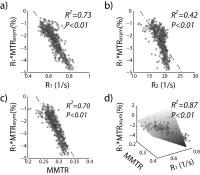 |
78 |
Stratification of graded acute stroke metabolic injury with
magnetization transfer and relaxation-normalized amide proton
transfer (MRAPT) pH-weighted MRI 
Phillip Zhe Sun1, Yingkun Guo1,2, Iris
Yuwen Zhou1, Suk-Tak Chan1, Yu Wang3,
Emiri Mandeville4, Eng H Lo4, and
Xunming Ji3
1Athinoula A. Martinos Center for Biomedical
Imaging, Department of Radiology, Massachusetts General
Hospital and Harvard Medical School, Charlestown, MA, United
States, 2Department
of Radiology, Key Laboratory of Obstetric & Gynecologic and
Pediatric Diseases and Birth Defects of Ministry of
Education, West China Second University Hospital, Sichuan
University, Chengdu, China, People's Republic of, 3Cerebrovascular
Diseases Research Institute, Xuanwu Hospital of Capital
Medical University, Beijing, China, People's Republic of, 4Neuroprotection
Research Laboratory, Department of Radiology and Neurology,
Massachusetts General Hospital and Harvard Medical School,
Charlestown, MA, United States
Amide proton transfer (APT) MRI probes amide protons from
endogenous proteins/peptides, which has shown promising
results in defining tissue acidosis. pH MRI complements
perfusion and diffusion MRI for enhanced stratification of
heterogeneous ischemic tissue injury. However, the
endogenous APT effect depends not only on pH but also on
tissue water content, MRI relaxation rates, and experimental
conditions. There are also concomitant RF irradiation
effects including direct RF saturation, magnetization
transfer and nuclear overhauser effects (NOE). Our study
evaluated magnetization transfer and relaxation-normalized
APT (MRAPT) MRI in an animal model of acute ischemic stroke
that enabled semiautomatic segmentation of graded ischemic
tissue injury.
|
|
2894.
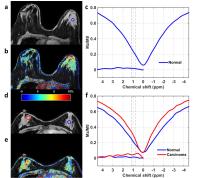 |
79 |
CEST-mDixon for Breast Lesion Characterization at 3T 
Shu Zhang1, Stephen Seiler1, Ananth
Madhuranthakam1,2, Jochen Keupp3, Ivan
E Dimitrov2,4, Robert E Lenkinski1,2,
and Elena Vinogradov1,2
1Radiology, UT Southwestern Medical Center,
Dallas, TX, United States, 2Advanced
Imaging Research Center, UT Southwestern Medical Center,
Dallas, TX, United States, 3Philips
Research, Hamburg, Germany, 4Philips
Medical Systems, Cleveland, OH, United States
In this work, the feasibility of mDixon-based CEST-MRI for
breast lesions characterization at 3T was explored. The
mDixon technique was used to acquire pure water CEST images
without fat contamination. The B0 maps
derived from mDixon technique were used for field
inhomogeneity correction. Human studies demonstrated marked
differences in MTRasym between
malignant and healthy tissue in hydroxyl range (0.8-1.8 ppm)
and amide range (3.1-4.1 ppm). In addition, the width of the
Z-spectrum was reduced in malignant vs healthy breast
tissue. The results suggest that the CEST-mDixon has the
potential as a robust detection and characterization tool of
breast malignancy.
|
|
2895.
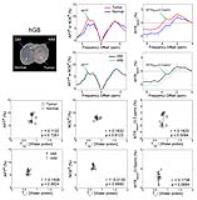 |
80 |
Identification of the Origin for Amide Proton Transfer (APT)
Imaging Signals in Multiple Pathologies 
Dong-Hoon Lee1, Hye-Young Heo1, Yi
Zhang1, Shanshan Jiang1, and Jinyuan
Zhou1
1Department of Radiology, Johns Hopkins
University School of Medicine, Baltimore, MD, United States
APT imaging can provide endogenous contrast related to the
mobile amide proton concentration, amide proton exchange
rate (depending on tissue pH), and other tissue and
experimental parameters. Here, based on the correlations
between quantified APT signals and combined parameter of
water proton concentration and water T1 (T1w/[water
proton]), we attempted to reveal the origin for APT imaging
signals in multiple disease models. The results showed no
significant correlations between APT signals and the T1w/[water
proton]. Our findings clearly indicated that the APT signals
is primarily related to the mobile amide proton
concentration and amide proton exchange rate.
|
|
2896.
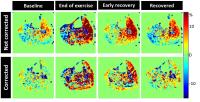 |
81 |
B0-calibrated and motion-registered dynamic CEST MRI of muscles
undergoing exercise 
Alessandro M Scotti1,2,3, Rong-Wen Tain1,3,
Xiaohong Joe Zhou1,2,3, and Kejia Cai1,3
1Radiology, University of Illinois, Chicago, IL,
United States, 2Bioengineering,
University of Illinois, Chicago, IL, United States, 3Center
for MR Research, University of Illinois, Chicago, IL, United
States
Artifacts arising from tissue motion and static field
inhomogeneities can heavily impact the measurement of
metabolites concentration in CEST-MRI experiments in vivo.
We present a correction strategy applied to CEST-MRI of
creatine concentration during muscle exercise. Corrections
consisted in image registration by means of a demons
algorithm and signal calibration over static field offsets
map at baseline, without the need of additional scanning.
After correction, results are in accord with conventionally
corrected data and published results. This method is shown
to be effective in dynamic studies, where a high temporal
resolution and coverage is required.
|
|
2897.
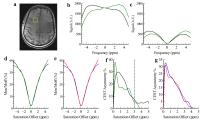 |
82 |
Localized, gradient-reversed ultrafast z-spectroscopy in vivo at
7T 
Neil Wilson1, Kevin D'Aquilla1,
Catherine Debrosse1, Hari Hariharan1,
and Ravinder Reddy1
1Department of Radiology, Center for Magnetic
Resonance and Optical Imaging (CMROI), University of
Pennsylvania, Philadelphia, PA, United States
Ultrafast z-spectroscopy can be collected by saturating the
nuclear spins with an RF pulse in the presence of a
gradient, effectively encoding the offset frequency
spatially across a voxel and allowing full z-spectra to be
collected in a single shot. When asymmetry analysis is
applied, frequencies on one physical side of the voxel are
compared with those on the other physical side. This can be
a problem if there is inhomogeneity or partial voluming. By
acquiring an additional z-spectrum with the gradient
polarity reversed, mixed z-spectra can be created in which
the positive and negative offset frequencies come from the
same side of the voxel. This method is more robust to
inhomogeneity and partial voluming typically found in vivo
as demonstrated here with studies on 7T in human brain.
|
|
2898.
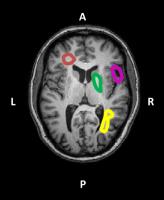 |
83 |
Can CEST be used as biomarker in Huntington’s disease? 
Marilena Rega1,2, James Fairney1,
Francisco Torrealdea1,3, Blair Leavitt4,
Rachel Schahill1, Raymund Roos5,
Bernhard Landwehrmeyer6, Beth Borowsky7,
Sarah Tabrizi1, and Xavier Golay1
1Institute of Neurology, University College
London, London, United Kingdom, 2Medical
Physics, University College London Hospital, London, United
Kingdom, 3Center
of Medical Imaging, University College London, London,
United Kingdom, 4Department
of Medical Genetics, University of British Columbia,
Vancouver, BC, Canada, 5Department
of Neurology, University Medical Center, Leiden, United
Kingdom, 6Department
of Neurology, Ulm University, Ulm, Germany, 7HighQ
foundation, CHDI, New York, NY, United States
Huntington’s is a hereditary disease caused by the HTT gene,
resulting in the aggregation of mutant huntingtin in the
cytoplasm. CEST, known to be affected by protein
concentration and structure, was considered a potential
biomarker for a clinical trial and comparison with MT, T1
and T2 relaxometry. Data were acquired in n=54 HD patients
and n=46 healthy individuals. Comparison of CEST revealed
significant differences (p<0.05) in the putamen and globus
pallidus regions which did not correlate with any changes in
relaxometry or MT, suggesting that CEST might be able to
provide additional contrast to the already existing
methods.
|
|
2899.
 |
84 |
Imaging the pH by means of CEST-responsive iopamidol: normal and
AKI model studies 
Wei Hu1, Zhuozhi Dai1, Zhiwei Shen1,
Yuanyu Shen1, Xiangyong Tang1, Zhiyan
Zhang1, Gang Xiao2, Phillip Zhe Sun3,
and Renhua Wu1
12nd Affilicated Hospital, Shantou University
Medical College, Shantou, China, People's Republic of, 2Hanshan
Normal University, Chao zhou, China, People's Republic of, 3Massachusetts
General Hospital and Harvard Medical School, Charlestown,
MA, United States
The promising imaging technique of chemical exchange
saturation transfer (CEST) MRI, which is sensitive to
microenvironment properties including pH, metabolites,
temperature, metal ions, and enzymatic activities, has been
increasingly applied in vivo such as acute ischemia,
infection and cancer. The aim of this work was to observe
the differentiation between normal and acute kidney injury
(AKI) using echo-planar imaging sequence (EPI) as well as
the sensitive ratiometric methods under 7T magnetic field.
|
|
2900.
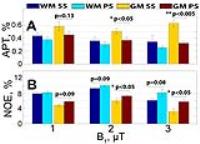 |
85 |
Comparison of 3D CEST acquisition schemes: steady state versus
pseudo-steady state 
Vitaliy Khlebnikov1, Nicolas Geades2,
Dennis WJ Klomp1, Hans Hoogduin1,
Penny Gowland2, and Olivier Mougin2
1Radiology, University Medical Center Utrecht,
Utrecht, Netherlands, 2Sir
Peter Mansfield Imaging Centre, University of Nottingham,
Nottingham, Nottinghamshire, United Kingdom, Nottingham,
United Kingdom
Chemical Exchange Saturation Transfer (CEST) has gained much
popularity due to its unmatched sensitivity to dilute labile
protons when compared to other MRI techniques. Of particular
interest are two CEST effects: Amide Proton Transfer (APT,
CEST of amides) and Nuclear Overhauser Enhancement (NOE).
Fast-paced developments for CEST resulted in the design of
multiple CEST imaging sequences. This raises the obvious
question as to which sequence to use and in what particular
applications. Two pulsed volumetric CEST acquisition schemes
are currently available in the literature. The first is
based on the standard Magnetization Transfer imaging
technique: a steady-state (SS) acquisition with alternating
brief saturation and image acquisition. The second is based
on the preparation of the magnetization before a long
readout, where the prolonged saturation reaches a
pseudo-steady state (PS) before the image acquisition. In
this report, these two CEST acquisition schemes, optimized
for maximum sensitivity to APT and NOE effects through
Bloch-McConnell simulations, were systematically compared
for the same spatial resolution, brain coverage and scan
time.
|
|
2901.
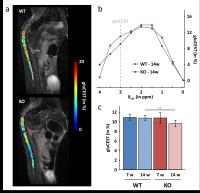 |
86 |
GluCEST imaging of spinal cord in a mouse model of Friedreich
ataxia 
Jérémy Pépin1,2, Françoise Piguet3,4,5,6,
Hélène Puccio3,4,5,6, and Julien Flament1,7
1CEA/DSV/I2BM/MIRCen, Fontenay-aux-Roses, France, 2CNRS
Université Paris-Saclay UMR 9199, Fontenay-aux-Roses,
France, 3Department
of Translational Medecine and Neurogenetics, Institut de
Génétique et de Biologie Moléculaire et Cellulaire,
Illkirch, France, 4INSERM
U596, Illkirch, France, 5CNRS
UMR7104, Illkirch, France, 6Université
de Strasbourg, Strasbourg, France, 7INSERM
UMS 27, Fontenay-aux-Roses, France
Friedreich Ataxia (FA) is the most common form of recessive
inherited ataxia which induces severe neurological
disabilities and reduced life expectancy. As glutamate has
been shown to be a potential biomarker of neurodegenerative
diseases, we used Chemical Exchange Saturation Transfer
imaging of glutamate (gluCEST) in order to characterize our
mouse model of FA and to monitor glutamate alterations in
the spinal cord. GluCEST images revealed decrease of
glutamate level in FA mouse model compared to control
littermates, especially in the lumbar part. These results
demonstrate the potential of gluCEST in providing innovative
and relevant biomarkers of FA.
|
|
2902.
 |
87 |
Tissue Characterization with Fast High Resolution Magic Angle
Spinning (HRMAS) CEST Spectroscopy 
Iris Yuwen Zhou1, Taylor Fuss1,2, Gang
Xiao3, Takahiro Igarashi1, Lin Li1,
Leo L. Cheng1,2, and Phillip Zhe Sun1
1Athinoula A. Martinos Center for Biomedical
Imaging, Department of Radiology, Massachusetts General
Hospital and Harvard Medical School, Charlestown, MA, United
States, 2Department
of Pathology, Massachusetts General Hospital and Harvard
Medical School, Boston, MA, United States, 3Department
of Mathematics and Statistics, Hanshan Normal University,
Chaozhou, China, People's Republic of
Z-spectrum is conventionally acquired through multiple
experiments with selective saturation at different frequency
offsets of interest, leading to extreme long acquisition
time. Here, we employ gradient-encoding to substantially
accelerate the acquisition of Z-spectrum. This speedup in
combination with higher spectral resolution provided by high
resolution magic angle spinning (HRMAS) allows rapid
quantification of chemical exchange rates of CEST agents,
monitoring dynamic processes and fast tissue
characterization. The approach was validated in phantom and
used for characterization of brain tissues after ischemic
stroke.
|
|
2903.
 |
88 |
GluCEST imaging: a relevant biomarker of Huntington’s disease. 
Jérémy Pépin1,2, Laetitia Francelle1,2,
Maria-Angeles Carillo-de Sauvage1,2, Huu Phuc
Nguyen3,4, Nicole El Massioui5,6,
Valérie Doyère5,6, Emmanuel Brouillet1,2,
and Julien Flament1,7
1CEA/DSV/I2BM/MIRCen, Fontenay-aux-Roses, France, 2CNRS
Université Paris-Saclay UMR 9199, Fontenay-aux-Roses,
France, 3Institute
of Medical Genetics and Applied Genomics, University of
Tuebingen, Tuebingen, Germany, 4Centre
for Rare Diseases, University of Tuebingen, Tuebingen,
Germany, 5Paris-Saclay
Institute of Neuroscience, Université Paris-Sud, UMR 9197,
Orsay, France, 6Centre
National de la Recherche Scientifique, Orsay, France, 7INSERM
UMS 27, Fontenay-aux-Roses, France
Huntington’s disease (HD) is an inherited neurodegenerative
disease characterized by motor, cognitive and psychiatric
symptoms. As glutamate has been shown to be a potential
biomarker of neurodegenerative diseases, we used Chemical
Exchange Saturation Transfer imaging of glutamate (gluCEST)
to map cerebral glutamate distribution in mouse and rat
models of HD. A decrease of [Glu] was measured in the
striatum by MRS and gluCEST. In addition, good spatial
resolution of gluCEST over MRS allowed identification of
other afflicted brain regions such as corpus callosum. These
results demonstrate the potential of gluCEST in providing
relevant biomarkers of HD in the whole brain.
|
|
2904.
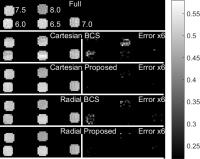 |
89 |
Accelerating CEST Imaging with Spatial-Temporal Sparse
Dictionary Learning 
Huajun She1, Bian Li1, Robert
Lenkinski1, and Elena Vinogradov1
1Radiology, Advanced Imaging Research Center, UT
Southwestern Medical Center, Dallas, TX, United States
This work investigates accelerating CEST imaging. The
original blind compressive sensing method assumes that a few
functions are enough to represent the dynamic behavior, and
the coefficient matrix should be sparse. In CEST imaging,
z-spectrum shows group sparsity in the same compartment. So
not only the coefficients matrix is sparse but also the
transformation of the coefficients matrix is sparse, such as
total variation and wavelets. The proposed method addresses
this prior information and further improves the original BCS
method, demonstrating a better estimation of the CEST effect
at high reduction factors for both Cartesian and radial
sampling patterns.
|
|
2905.
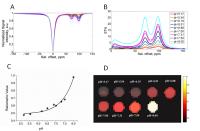 |
90 |
Use of Yb-HPDO3A probe for CEST-MRI pH mapping in glioblastoma
mouse models 
Giuseppe Ferrauto1, Michel Sarraf2,
Enza Di Gregorio1, Vincent Auboiroux3,
Ulysse Gimenez2, François Berger2,
Silvio Aime1, and Hana Lahrech2
1Dept of Molecular Biotechnologies & Health
Sciences, University of TORINO (IT), Torino, Italy, 2CLINATEC-CEA-INSERM
UA01 – CHU –UJF Grenoble (FR), Grenoble, France, 3CLINATEC-CEA
Grenoble (FR), Grenoble, France
MRI maps of extracellular/extravascular pH distribution in
glioblastoma mouse model (U87 cells) have been obtained by
administrating YbHPDO3A CEST probe. This molecule has
potential in a clinical setting as it displays analogue
properties (stability and in vivo pharmacokinetic) of its
analogue clinically approved Gd-HPDO3A (ProHance).
Furthermore, glioblastoma pH maps have been correlated with
histology (H/E, Hif-1a and Ki-67 staining). The assessment
of glioblastoma pHe could be used to monitor tumor
development and to target acidic tumor regions using
innovative responsive pH therapies.
|
|
2906.
 |
91 |
Comparison of gagCEST and sodium MRI in evaluating knee
cartilage in vivo at 7 Tesla - Permission Withheld
Vladimir Mlynarik1,2, Stefan Zbyn1,
Markus Schreiner3, Vladimir Juras1,
Pavol Szomolanyi1, Didier Laurent4,
and Siegfried Trattnig1,2
1Department of Biomedical Imaging and
Image-Guided Therapy, High Field MR Center, Medical
University of Vienna, Vienna, Austria, 2CD
Laboratory for Clinical Molecular MR Imaging, Vienna,
Austria,3Department of Orthopedic Surgery,
Medical University of Vienna, Vienna, Austria, 4Novartis
Institutes for Biomedical Research, Basel, Switzerland
There are several methodological and data processing issues
in gagCEST, which complicate the translation of this method
into clinical practice. For assessing performance of the
gagCEST protocol optimized in our laboratory, corrected
signal intensities from sodium images were used as a
reference. The results demonstrate a good
correlation between both methods, although the small
magnitude of the gagCEST effect and the low resolution in
sodium images require carefully optimized methodology and
long measurement times. It can be concluded that the gagCEST
method can be useful in evaluating early degeneration of
articular cartilage at 7 Tesla.
|
 |
2907.
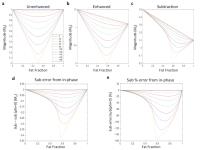 |
92 |
Chemical shift artifact of the third kind: Implications for
gradient-echo based contrast enhanced imaging 
Jamal J. Derakhshan1, Elizabeth S. McDonald2,
Evan S. Siegelman3, Mitchell D. Schnall3,
and Felix W. Wehrli4
1Radiology, Hospital of the University of
Pennsylvania, Philadelphia, PA, United States, 2Radiology,
Breast Imaging Division, Hospital of the University of
Pennsylvania, Philadelphia, PA, United States,3Radiology,
Abdominal Imaging Division, Hospital of the University of
Pennsylvania, Philadelphia, PA, United States, 4Radiology,
University of Pennsylvania, Philadelphia, PA, United States
A common subtraction band artifact in breast MRI was not
understood, causing reduced confidence in clinical
interpretation. The source of the artifact is shown to be a
subtle chemical shift effect between fat and water in the
presence of contrast enhancement. The phenomenon is now
generalized and characterized at all off-resonance angles.
Strong echo-time and fat signal dependence may lead to
enhancement errors as a function of scanner hardware, field
strength and fat suppression limitations. A time and
SNR-equivalent in-phase VIBE sequence eliminates the
artifact; gradient-echo based contrast enhanced imaging can
be performed in-phase to eliminate these important potential
pitfalls.
|
|
2908.
 |
93 |
Fixed Angle Single Rotation CEST (FASR-CEST) sequence for
reducing saturation time 
Yi Wang1, Yang Fan2, Bing Wu2,
and Jia-Hong Gao1
1School of Physics, Peking University, Beijing,
China, People's Republic of, 2MR
Research Group, GE Healthcare China, Beijing, China,
People's Republic of
In CEST imaging, when saturation time is not sufficient long
(empirically smaller than 0.8s), rotation effect would
appear and contaminate with saturation effect, making the
signal unavailable for further analysis. Considering the
inhomogeneity of $$$B_{0}$$$ and $$$B_{1}$$$ in reality, we
propose a novel Fixed Angle Single Rotation CEST(FASR-CEST)
sequence to overcome the restriction, successfully reducing
the saturation time to about 0.5s while keeping identical
effect as CEST sequence with long saturation time, with the
help of analytical calibration method in another abstract.
Effect of the sequence is verified with vitro and in
vivo data.
|
|
2909.
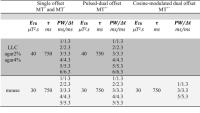 |
94 |
T1D-w ihMT: Dipolar Relaxation time weighted imaging using
inhomogeneous Magnetization Transfer - Permission Withheld
Guillaume Duhamel1, Valentin H Prevost1,
Gopal Varma2, David C Alsop2, and
Olivier M Girard1
1CRMBM / CNRS 7339, Aix Marseille University,
Marseille, France, 2Radiology,
Division of MR Research, Beth Israel Deaconess Medical
Center, Harvard Medical School, Boston, MA, United States
The inclusion of a dipolar reservoir in the existing two
pool model for MT allowed interpreting the inhomogeneous MT
(ihMT) signal as a dipolar order effect -characterized by a
relaxation time T1D -
within motion restricted molecules. In this study, we
demonstrate that an ihMT signal can actually be evidenced in
any component with non-trivial T1D value.
Adjustment of the dual frequency irradiation efficiency by
increase of Δt, the repetition rate of consecutive
saturation pulses, filters the signal of shorter T1D components.
This provides a means to realize T1D-weighted
imaging, a new source of MR contrast between tissues.
|
|
2910.
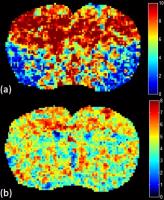 |
95 |
Improvement of in vivo glucoCEST imaging in rat brain using
inverse z-spectrum analytical scheme at 7.0 T 
Ping-Huei Tsai1,2,3, Hua-Shan Liu4,5,
Fei-Ting Hsu6, Yu-Chieh Kao3,
Chia-Feng Lu3, Li-Chun Hsieh2,
Pen-Yuan Liao2, Hsiao-Wen Chung7, and
Cheng-Yu Chen1,2,3
1Department of Radiology, School of Medicine,
College of Medicine, Taipei Medical University, Taipei,
Taiwan, 2Department
of Medical Imaging, Taipei Medical University Hospital,
Taipei Medical University, Taipei, Taiwan, 3Translational
Imaging Research Center, Taipei Medical University, Taipei,
Taiwan, 4Graduate
Institute of Clinical Medicine, Taipei Medical University,
Taipei, Taiwan,5Department of Medical Imaging,
Taipei Medical University Hospital, Taipei, Taiwan, 6Taipei
Medical University Hospital, Taipei Medical University,
Taipei, Taiwan, 7Graduate
Institute of Biomedical Electronics and Bioinformatics,
National Taiwan University, Taipei, Taiwan
GlucoCEST have been proposed to assess the discrepant
concentrations of glucose in vitro. However, it is still a
challenge to obtain accurate signals from glucose in vivo.
Our preliminary finding demonstrated that the proposed
analytical scheme provides an alternative to extract glucose
profile and could be more robust to the field inhomogeneity,
which may be helpful in further implementation in disease
models.
|
|
2911.
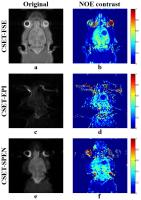 |
96 |
A fast chemical exchange saturation transfer imaging scheme
based on spatiotemporal encoding 
Jianpan Huang1, Miao Zhang1, Shuhui
Cai1, Congbo Cai2, Lin Chen1,
and Ting Zhang1
1Department of Electronic Science, Xiamen
University, Xiamen, China, People's Republic of, 2Department
of Communication Engineering, Xiamen University, Xiamen,
China, People's Republic of
Chemical exchange saturation transfer (CEST) is widely
exploited in magnetic resonance imaging (MRI) because of its
special quantitative contrast mechanisms. To overcome the
long acquisition time required by fast spin-echo multi-slice
imaging and alleviate the sensitivity to field inhomogeneity
and chemical shift effects appeared in echo planar imaging,
we proposed a CEST imaging scheme based on spatiotemporally
encoded magnetic resonance imaging (SPEN MRI). Experimental
results validated the feasibility and capability of the new
scheme.
|
|


